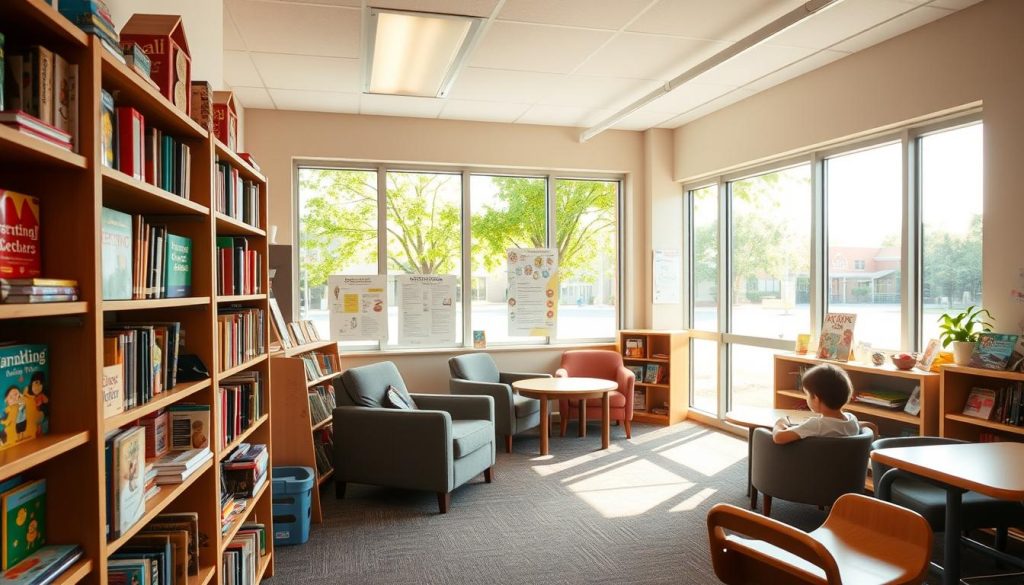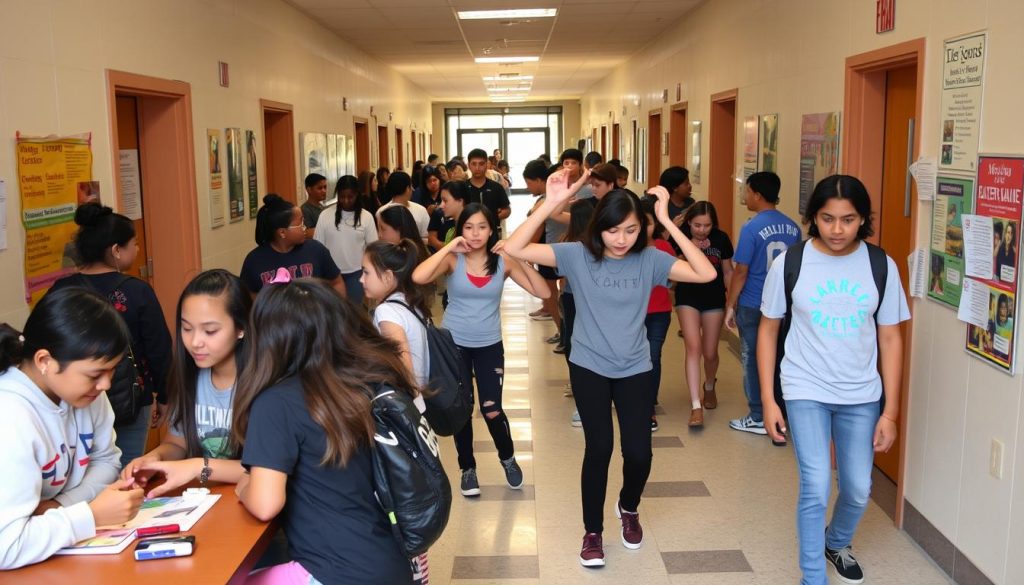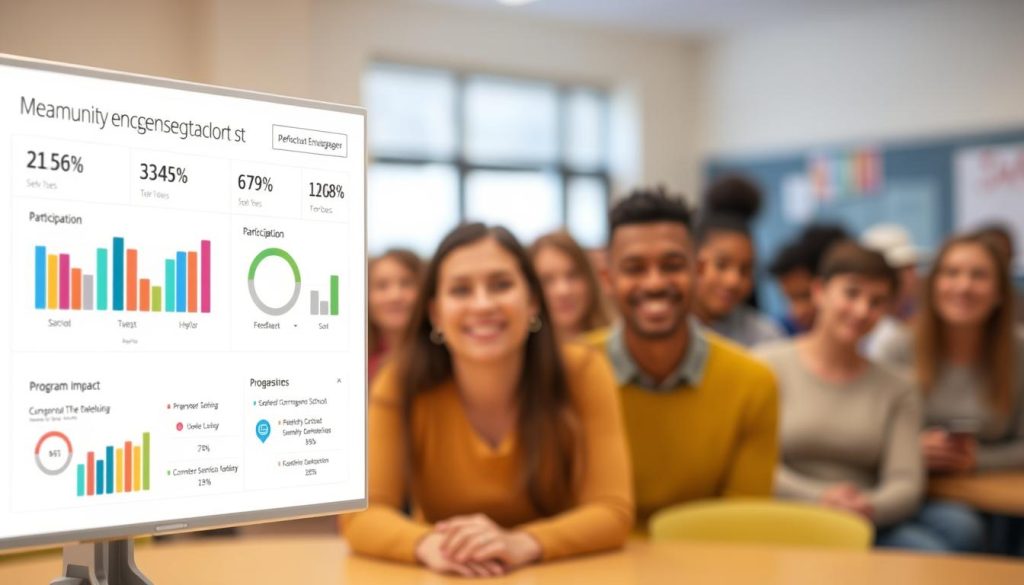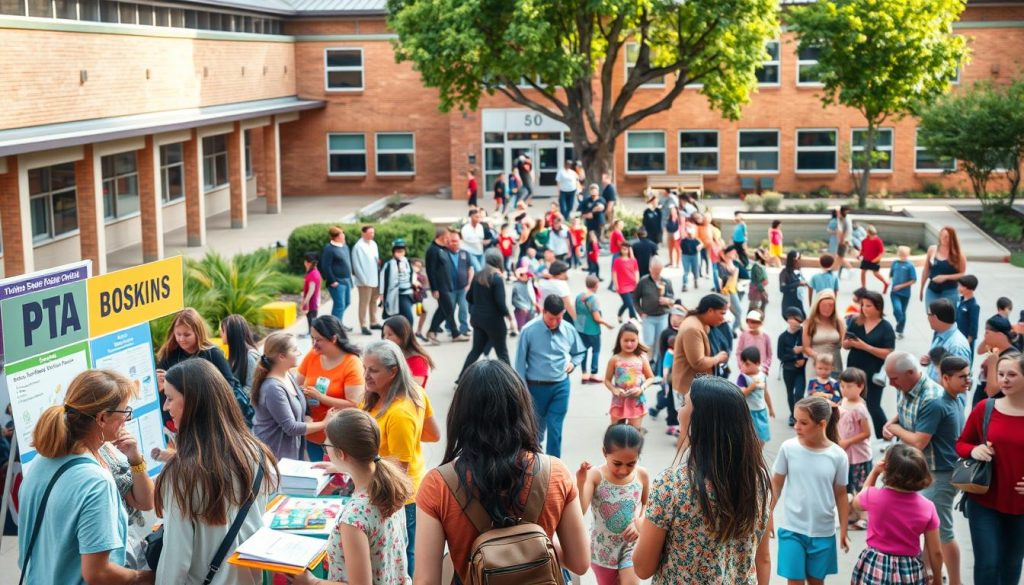Building a strong school community is crucial for the success of students, teachers, and parents alike. One effective way to foster this sense of community is through engaging events that bring everyone together.
Events like PTA meetings and family events play a significant role in promoting school community engagement. They provide opportunities for parents, teachers, and students to interact, share ideas, and work together towards common goals.
By organizing such events, schools can create a more inclusive and supportive environment, ultimately benefiting the students and the community as a whole.
Key Takeaways
- Engaging events foster a sense of community in schools.
- PTA meetings and family events promote interaction among parents, teachers, and students.
- A strong school community benefits students and the community.
- Events help create an inclusive and supportive environment.
- School community engagement is crucial for overall success.
The Value of School Community Engagement
The importance of community involvement in schools cannot be overstated, as it plays a significant role in student success. When parents, teachers, and the broader community come together, they create a robust support system that benefits students in multiple ways.
Building Stronger Educational Foundations
A strong school community lays the groundwork for a quality education. By engaging with the school, parents can contribute to decision-making processes, volunteer in classrooms, and support educational initiatives. This collaborative approach helps in developing a well-rounded curriculum that meets the needs of all students.
Creating a Supportive Environment for Students
A supportive environment is crucial for students’ academic and personal growth. Community engagement helps foster this environment by promoting positive relationships among students, teachers, and parents.
Academic Benefits of Parent Involvement
Research has shown that parent involvement is linked to improved academic performance. When parents are engaged, students tend to have better attendance, higher grades, and improved behavior.
Social-Emotional Advantages for Children
Community engagement also has social-emotional benefits for children. It helps them develop important life skills such as communication, empathy, and teamwork. A supportive community environment can enhance students’ self-esteem and confidence.
| Benefits | Academic | Social-Emotional |
|---|---|---|
| Parent Involvement | Better attendance, higher grades | Improved communication, empathy |
| Community Engagement | Enhanced educational outcomes | Develops teamwork, self-esteem |
PTA or Advisory Council Meetings: The Backbone of School Engagement
PTA and advisory council meetings serve as the foundation for fostering a collaborative environment within schools. These gatherings are crucial for discussing various aspects of school life, from educational programs to community events.
The Role and Purpose of PTAs in American Schools
PTAs play a vital role in American schools by providing a platform for parents, teachers, and administrators to come together and discuss matters of mutual interest. Their primary purpose is to support the school’s mission and enhance the educational experience for students.
How Advisory Councils Function in the US Education System
Advisory councils, on the other hand, often focus on advising the school administration on policies and programs. They may comprise parents, teachers, students, and community members who work together to identify areas for improvement and develop strategies for growth.
Meeting Structures and Participation Guidelines
Effective meetings require a clear structure and guidelines for participation. This includes setting a well-defined agenda, establishing rules for discussion, and ensuring that all attendees have an opportunity to contribute.
Effective Meeting Management Techniques
To manage meetings effectively, it’s essential to start on time, stay focused on the agenda, and summarize key decisions. Encouraging active participation and maintaining a respectful atmosphere are also crucial.
Here are some key techniques for effective meeting management:
| Technique | Description | Benefits |
|---|---|---|
| Clear Agenda | Distribute the agenda in advance | Keeps the meeting focused |
| Active Participation | Encourage all attendees to contribute | Fosters a collaborative environment |
| Time Management | Start and end the meeting on time | Respects attendees’ time |
Establishing and Revitalizing Your School’s PTA
Establishing or revitalizing a PTA is a crucial step in enhancing school involvement. A strong PTA can significantly impact the educational experience by fostering a collaborative environment between parents, teachers, and students.
Joining an Existing PTA Organization
If your school already has a PTA, joining is a great way to get involved. You can start by attending meetings, volunteering for committees, and participating in events. This helps you understand the existing structure and identify areas where you can contribute.
Starting a New PTA Chapter at Your School
For schools without a PTA, starting a new chapter can be a rewarding initiative. Begin by gathering interest from other parents and teachers, then follow the National PTA’s guidelines for registration and establishment.
Leadership Roles and Responsibilities
Effective leadership is crucial for a PTA’s success. Key roles include the president, treasurer, and secretary. Each role has specific responsibilities, such as overseeing meetings, managing finances, and recording minutes.
Recruiting and Retaining Active Members
To keep your PTA active, focus on recruiting and retaining members. Strategies include:
- Hosting engaging events
- Utilizing social media for promotion
- Offering various volunteer opportunities
| Role | Responsibilities |
|---|---|
| President | Oversees meetings, sets agendas |
| Treasurer | Manages finances, prepares budgets |
| Secretary | Records minutes, handles correspondence |
By understanding these roles and responsibilities, you can help build a strong and effective PTA that benefits your school community.
Planning Successful Family Fun Days and Open Houses
By hosting family fun days and open houses, schools can encourage parental involvement and student engagement. These events are crucial for building a strong, supportive community around the school.
Seasonal Event Ideas That Engage the Whole Family
To make family fun days and open houses appealing, consider organizing events around different seasons or holidays. For example, a fall festival with pumpkin carving, or a spring fling with egg hunts, can be great attractions. These events not only provide entertainment but also create opportunities for families to interact with teachers and other parents.
- Host a science fair or a math night to showcase student projects.
- Organize a book fair or a literacy night to promote reading.
- Plan a sports day or a health fair to encourage physical activity.
Budgeting and Resource Allocation for School Events
Effective budgeting is key to the success of family fun days and open houses. Schools should allocate resources wisely, considering both the costs and the potential benefits of each event. It’s essential to involve parents and community members in the planning process to secure donations or volunteer support.
Promotion Strategies for Maximum Attendance
To maximize attendance, schools need to promote their events effectively. This can be achieved through a combination of traditional and digital marketing strategies.
Digital Marketing for School Community Events
Utilizing digital platforms can significantly enhance the visibility of school events. Schools can use social media to create event pages, share updates, and engage with parents. Email newsletters and text message alerts are also effective tools for promoting events and encouraging attendance.
By leveraging these strategies, schools can ensure that their family fun days and open houses are well-attended and successful, ultimately strengthening the school community.
Designing Meaningful Open Houses That Showcase Your School
A well-designed open house can significantly enhance your school’s visibility and foster a sense of belonging among parents and students. To achieve this, it’s essential to plan an event that not only showcases your school’s strengths but also provides a platform for meaningful interactions between teachers, students, and parents.
Classroom Demonstrations and Student Work Displays
One of the highlights of an open house is the opportunity for students to showcase their work and for teachers to demonstrate their teaching methods. Classroom demonstrations can range from science experiments to math problem-solving sessions, giving parents a glimpse into the daily learning experiences of their children. Similarly, displaying student work in classrooms or hallways can illustrate the breadth of student achievements and creativity.
To make these displays even more impactful, consider including brief explanations of the projects, the skills they develop, and how parents can support their children in similar activities at home.
Faculty and Staff Engagement Opportunities
Open houses are an ideal time for faculty and staff to engage with parents and guardians. Informal meet-and-greets can help establish a personal connection between teachers and parents, laying the groundwork for future communication. Additionally, having teachers available to discuss student progress and answer questions can provide valuable insights to parents.
Consider organizing special sessions or Q&A forums where parents can learn more about specific aspects of the school’s curriculum or policies. This not only informs parents but also demonstrates the school’s commitment to transparency and community engagement.
Follow-up Strategies After Open House Events
The impact of an open house can be extended through effective follow-up strategies. Sending a post-event survey can help gather feedback from attendees, providing insights into what worked well and areas for improvement. Additionally, sharing photos and highlights on the school’s website or social media channels can keep the momentum going and give those who couldn’t attend a sense of what happened.
Following up with personalized emails or notes to parents thanking them for their participation can further reinforce the sense of community and appreciation for their involvement.
Essential Parenting Resources Through Your School Community
Empowering parents with the right resources is crucial for a thriving school community. By providing access to valuable information and support, schools can help parents navigate the challenges of raising children and foster a more engaged and involved community.
Educational Workshops for Parents of Different Age Groups
Educational workshops tailored to parents of children at different ages can be incredibly beneficial. For instance, workshops on child development, discipline techniques, and how to support learning at home can be very helpful. Schools can invite experts to lead these workshops, covering topics such as:
- Understanding child development stages
- Managing screen time and digital safety
- Supporting students with special needs
Creating Support Networks for Families
Creating support networks for families is another vital aspect of providing parenting resources. This can be achieved through:
- Parent-teacher conferences
- Parent support groups
- Volunteer opportunities
These networks help parents connect with each other, share experiences, and build relationships that can lead to a stronger, more supportive community.
Connecting Parents with Community Resources
Schools can also play a key role in connecting parents with broader community resources. This can include:
- Referrals to local counseling services
- Information about after-school programs
- Details on community events and activities
Digital and Print Resources for Modern Parents
In today’s digital age, providing both digital and print resources can cater to the diverse needs of parents. This can include:
- Online portals with parenting tips and advice
- Newsletters that keep parents informed about school events and activities
- Printed materials such as brochures and guides on various parenting topics
As one parenting expert notes,
“Having access to a variety of resources can make a significant difference in a parent’s ability to support their child’s education.”

By offering a range of resources and support, schools can help parents feel more confident and capable in their role, ultimately benefiting the entire school community.
Strengthening Parent-Teacher Communication Channels
Parent-teacher communication plays a vital role in fostering a supportive learning environment. When parents and teachers are in sync, students benefit greatly from the cohesive support system.
Digital Communication Platforms for American Schools
Utilizing digital platforms can significantly enhance parent-teacher communication. Tools like email, school management software, and dedicated parent-teacher communication apps have made it easier to share updates and feedback.
Regular Updates and Newsletters That Engage Families
Regular newsletters and updates keep parents informed about school activities, curriculum changes, and their child’s progress. This consistent flow of information helps in building trust and encourages parental involvement.
“The key to successful parent-teacher communication is consistency and clarity.” – Education Expert
Creating Open Dialogue Opportunities Throughout the Year
Creating opportunities for open dialogue is crucial. This can be achieved through parent-teacher conferences, volunteer opportunities, and feedback mechanisms that allow for two-way communication.
| Communication Method | Frequency | Benefit |
|---|---|---|
| Digital Platforms | Daily/Weekly | Immediate Updates |
| Newsletters | Monthly | Comprehensive Overview |
| Parent-Teacher Conferences | Quarterly | In-depth Progress Discussion |
Student-Led Initiatives for Community Building
By empowering students to take the lead, schools can foster a stronger sense of community. Student-led initiatives not only enhance community engagement but also provide valuable opportunities for students to develop leadership skills.
Empowering Student Voices in School Activities
Empowering student voices is crucial for creating an inclusive and dynamic school environment. Schools can achieve this by involving students in decision-making processes and encouraging them to take ownership of various projects and activities.
Peer Mentoring and Leadership Programs
Peer mentoring and leadership programs are effective ways to promote student activities and build a supportive community. These programs allow students to guide and support their peers, fostering a sense of camaraderie and shared responsibility.

Connecting Student Projects with Community Needs
Connecting student projects to community needs helps students understand the impact of their work and fosters a sense of social responsibility. This connection can be achieved by aligning school projects with local community initiatives.
Showcasing Student Achievements to the Community
Showcasing student achievements to the community not only boosts student morale but also promotes a positive image of the school. This can be done through events, exhibitions, or digital platforms that highlight student accomplishments.
| Initiative | Impact | Benefit |
|---|---|---|
| Peer Mentoring | Supports students academically and socially | Fosters a sense of community |
| Leadership Programs | Develops leadership skills in students | Prepares students for future challenges |
| Community Projects | Aligns school work with community needs | Enhances social responsibility |
Partnering with Local Businesses and Organizations
Partnering with local businesses and organizations can significantly enhance your school’s community engagement. By collaborating with local entities, schools can access resources, expertise, and networks that can enrich educational experiences and foster a stronger sense of community.
Sponsorship Opportunities for School Events
Local businesses can provide sponsorship for school events, helping to fund activities that might otherwise be unfeasible due to budget constraints. This not only benefits the school but also offers businesses a chance to engage with the community and promote their services or products.
Educational Partnerships and Field Trips
Educational partnerships can lead to valuable learning opportunities, such as field trips to local businesses or organizations. These experiences can provide students with real-world insights into various industries and professions.
| Partnership Type | Benefits | Examples |
|---|---|---|
| Sponsorship | Financial support for events | Funding for sports teams, cultural events |
| Educational Partnerships | Enhanced learning experiences | Field trips, guest lectures |
| Community Service | Opportunities for student volunteering | Clean-up initiatives, charity drives |
By leveraging these partnerships, schools can create a more engaging and supportive environment for their students, ultimately strengthening community ties.
Measuring the Impact of Your School Community Engagement
Assessing the impact of community engagement helps schools identify areas of strength and opportunities for growth. To effectively measure this impact, schools can employ several strategies.
Attendance and Participation Metrics
One of the most straightforward ways to measure community engagement is by tracking attendance and participation in school events. This includes events like PTA meetings, family fun days, and open houses.
Key metrics to consider:
- Number of attendees
- Participation rates in activities
- Demographic breakdown of attendees
Feedback Collection and Analysis Methods
Collecting feedback from parents, students, and staff is crucial for understanding the effectiveness of community engagement initiatives. This can be done through surveys, focus groups, and comment cards.
Effective feedback collection methods include:
- Online surveys with clear, concise questions
- Focus groups with diverse participants
- Comment cards at events
Adjusting Strategies Based on Results
Once data is collected, it’s essential to analyze it and adjust community engagement strategies accordingly. This might involve changing the format of events, increasing promotional efforts, or focusing on different areas of engagement.
Celebrating Successes and Recognizing Contributors
Recognizing the efforts of volunteers, staff, and students who contribute to community engagement is vital. Celebrating successes, no matter how small, helps to foster a positive and inclusive community.
| Metric | Pre-Engagement | Post-Engagement |
|---|---|---|
| Attendance | 100 | 150 |
| Participation Rate | 50% | 75% |
| Feedback Score | 3.5/5 | 4.5/5 |

Overcoming Common Challenges in School Community Engagement
Building a strong school community is crucial, but it comes with its own set of challenges that need to be addressed. Schools often face difficulties in engaging families and fostering a sense of community due to various constraints.
Addressing Time Constraints for Busy American Families
Many families in the United States lead busy lives, making it challenging to participate in school activities. To address this, schools can offer flexible scheduling for events, ensuring that they are accessible to a wider audience. Utilizing digital platforms for communication and engagement can also help reach families who cannot attend in-person events.
Managing Volunteer Burnout and Succession Planning
Volunteer burnout is a common issue in school communities. To mitigate this, schools should focus on succession planning, identifying and training new leaders to take over roles as needed. Recognizing and appreciating volunteers’ efforts can also help prevent burnout.
Bridging Communication Gaps in Diverse Communities
Diverse communities often face communication challenges due to language barriers or cultural differences. Schools can bridge these gaps by providing multilingual communication channels and culturally sensitive materials. This inclusive approach helps ensure that all families feel welcome and informed.
Inclusive Approaches for All Family Structures
Inclusive communication is key to engaging diverse family structures. Schools should adopt gender-neutral language and recognize various family configurations in their communications. This approach fosters a welcoming environment for all families, regardless of their composition.
Conclusion: Building a Lasting School Community Legacy
Fostering a strong school community is crucial for the educational success and personal growth of students. By implementing the strategies discussed, such as PTA meetings, family fun days, and open houses, schools can cultivate a supportive environment that encourages parental support and community engagement.
A lasting school community legacy is built on the foundation of cooperation and mutual understanding among parents, teachers, and students. By working together, schools can create a positive and inclusive atmosphere that benefits everyone involved. Effective community engagement not only enhances the educational experience but also contributes to the overall well-being of the community.
As you move forward, consider the ideas and strategies presented in this article to strengthen your school community. By doing so, you can create a lasting legacy that benefits your school and the wider community, promoting a culture of cooperation and mutual support.
FAQ
What is the purpose of a PTA or advisory council meeting?
The primary purpose of a PTA or advisory council meeting is to facilitate communication and collaboration between parents, teachers, and administrators, driving school improvement initiatives and community engagement.
How can I get involved in my child’s school PTA?
To get involved, attend a PTA meeting, reach out to the PTA chair or committee members, and express your interest in participating. You can also volunteer for committees or take on a leadership role.
What are some ideas for planning a successful Family Fun Day?
Consider hosting a seasonal event, such as a Halloween costume contest, a Thanksgiving food drive, or a spring fling. You can also organize activities like face painting, bounce houses, or a school carnival.
How can I help my child feel more connected to the school community?
Encourage your child to participate in school activities, such as sports, clubs, or volunteer work. You can also attend school events, like parent-teacher conferences, open houses, or family fun days.
What are some effective ways to communicate with teachers and administrators?
Utilize digital communication platforms, such as email or online portals, to stay informed about school news and events. You can also attend parent-teacher conferences, PTA meetings, or volunteer in the classroom.
How can I support my child’s educational journey through the school community?
Attend educational workshops, join a parent organization, or volunteer in the classroom. You can also connect with other parents and families through school events or online forums.
What are some strategies for measuring the impact of school community engagement?
Track attendance and participation metrics, collect feedback through surveys or focus groups, and analyze the data to adjust your strategies. Celebrate successes and recognize contributors to foster a sense of community.
How can I help bridge communication gaps in a diverse school community?
Use inclusive language, provide translation services when necessary, and engage with families through various channels, such as social media, email, or in-person events.
What are some ways to address time constraints for busy families?
Offer flexible scheduling for events, provide online resources and updates, and involve families in planning to ensure their needs are met. You can also consider virtual events or activities.
How can I get local businesses involved in supporting our school community?
Reach out to local businesses to explore sponsorship opportunities, educational partnerships, or community service learning projects. Highlight the benefits of partnering with your school, such as increased visibility and community engagement.




